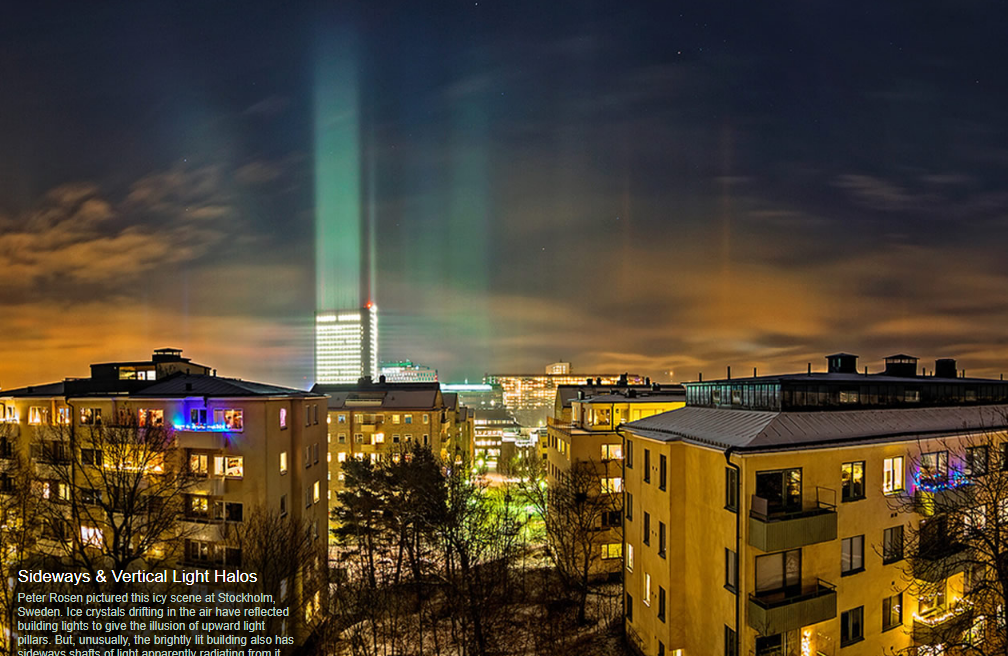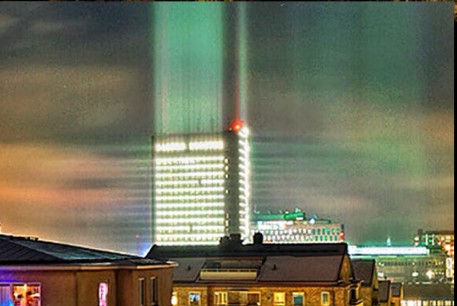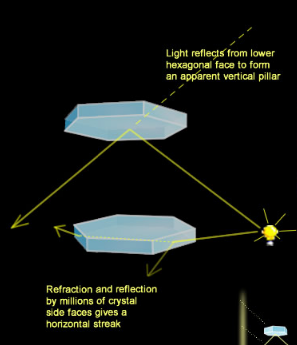Sideways & Vertical Light Pillars - OPOD
Sideways & Vertical Light Pillars: A Phenomenon Explained
Have you ever witnessed the mesmerizing sight of light pillars seemingly shooting upwards from buildings or radiating sideways? These captivating atmospheric optics phenomena occur when ice crystals are present in the air, reflecting and refracting light in unique ways. In this article, we will delve into the science behind sideways and vertical light pillars, unraveling their formation and shedding light on their enchanting appearance.
The Role of Plate-Aspect Ice Crystals
Plate-aspect ice crystals play a crucial role in the creation of both vertical and sideways light pillars. These crystals, shaped like hexagons, drift in the cold air. When ground lights illuminate them, the hexagonal faces of the crystals reflect the light back downwards, resulting in the formation of vertical light pillars. This is the conventional explanation for vertical light pillars observed in various locations.
Unraveling Sideways Light Pillars
However, when it comes to sideways light pillars, the mechanism behind their formation is slightly different yet equally fascinating. The main source of these sideways shafts of light is refraction through the near vertical side faces of the plate-aspect ice crystals. The paths of the rays of light that create these pillars are similar to those forming 22° sundogs, but with one key difference - while sunrays are parallel, the rays from building lights diverge. This divergence results in a horizontal streak known as a divergent light parhelion.
The Presence of Superparhelion
In certain instances, a phenomenon known as a superparhelion can also occur alongside the sideways light pillars. The superparhelion manifests as traces of light located at the upper left portion of the scene. This optical phenomenon arises from the same refraction and reflection processes as the sideways columns but presents itself as an intensified version of the parhelion.
The Formation of Divergent Light 'Parhelic Circle'
The external side faces of the ice crystals play another important role in the creation of these captivating optical displays. Reflection from these crystal side faces generates a divergent light 'parhelic circle.' Similar to the sideways light pillars, this parhelic circle appears as a horizontal streak, albeit fainter in comparison. Together, these various phenomena combine to create a truly awe-inspiring spectacle.
A Different Perspective: Looking Up and Down
To gain a comprehensive understanding of the formation of sideways and vertical light pillars, let's examine the phenomenon from two different perspectives - looking up and looking down. When we observe the scene from an elevated position, we can witness plate crystals positioned roughly midway between the light source and our eyes. These crystals reflect the light downwards, creating the illusion of a vertical pillar shooting upwards.
Conversely, when we shift our gaze downwards, we encounter a striking sight - an apparent horizontal light shaft produced by refraction and reflection from the side faces of the ice crystals. In this perspective, the divergent light parhelion becomes much more pronounced, captivating our attention with its radiant display.
In conclusion, sideways and vertical light pillars are atmospheric optics phenomena that result from the presence of plate-aspect ice crystals in the air. Through a combination of reflection and refraction, these crystals create mesmerizing displays of light that seemingly shoot upwards or radiate sideways from illuminated buildings. By unraveling the science behind these phenomena, we can appreciate the beauty and wonder of the natural world that surrounds us.

Sideways & Vertical Light Halos
Peter Rosen pictured this icy scene at Stockholm, Sweden. Ice crystals drifting in the air have reflected building lights to give the illusion of upward light pillars. But, unusually, the brightly lit building also has sideways shafts of light apparently radiating from it. And there is more.
Image ©Peter Rosen, shown with permission


Plate-aspect ice crystals are responsible for 'conventional' vertical light pillars. The crystals drift in cold air. Ground lights are reflected back downwards by their hexagonal faces.
Peter Rosen's sideways columns are likely created from the same crystals. But this time the main source is by refraction through the near vertical crystal side faces. The ray paths are the same as those forming 22° sundogs but the difference is that sunrays are parallel while the building light rays diverge. The divergent light parhelion is a horizontal streak. A superparhelion can also form and there are traces of it at upper left.
Reflection from the external crystal side faces forms a divergent light 'parhelic circle'. That is also a horizontal streak but rather fainter.
Many thanks to Nicolas Lefaudeux for very valuable comments.

Another way of looking:
The elevation shows plate crystals roughly midway between the light and the eye reflecting downwards to produce an apparent vertical pillar.
Looking downwards we see an apparent horizontal light shaft produced by refraction and reflection from the crystal side faces. The divergent light parhelion is much the stronger.
Note: this article has been automatically converted from the old site and may not appear as intended. You can find the original article here.
Reference Atmospheric Optics
If you use any of the definitions, information, or data presented on Atmospheric Optics, please copy the link or reference below to properly credit us as the reference source. Thank you!
-
<a href="https://atoptics.co.uk/blog/sideways-vertical-light-pillars-opod/">Sideways & Vertical Light Pillars - OPOD</a>
-
"Sideways & Vertical Light Pillars - OPOD". Atmospheric Optics. Accessed on November 25, 2024. https://atoptics.co.uk/blog/sideways-vertical-light-pillars-opod/.
-
"Sideways & Vertical Light Pillars - OPOD". Atmospheric Optics, https://atoptics.co.uk/blog/sideways-vertical-light-pillars-opod/. Accessed 25 November, 2024
-
Sideways & Vertical Light Pillars - OPOD. Atmospheric Optics. Retrieved from https://atoptics.co.uk/blog/sideways-vertical-light-pillars-opod/.